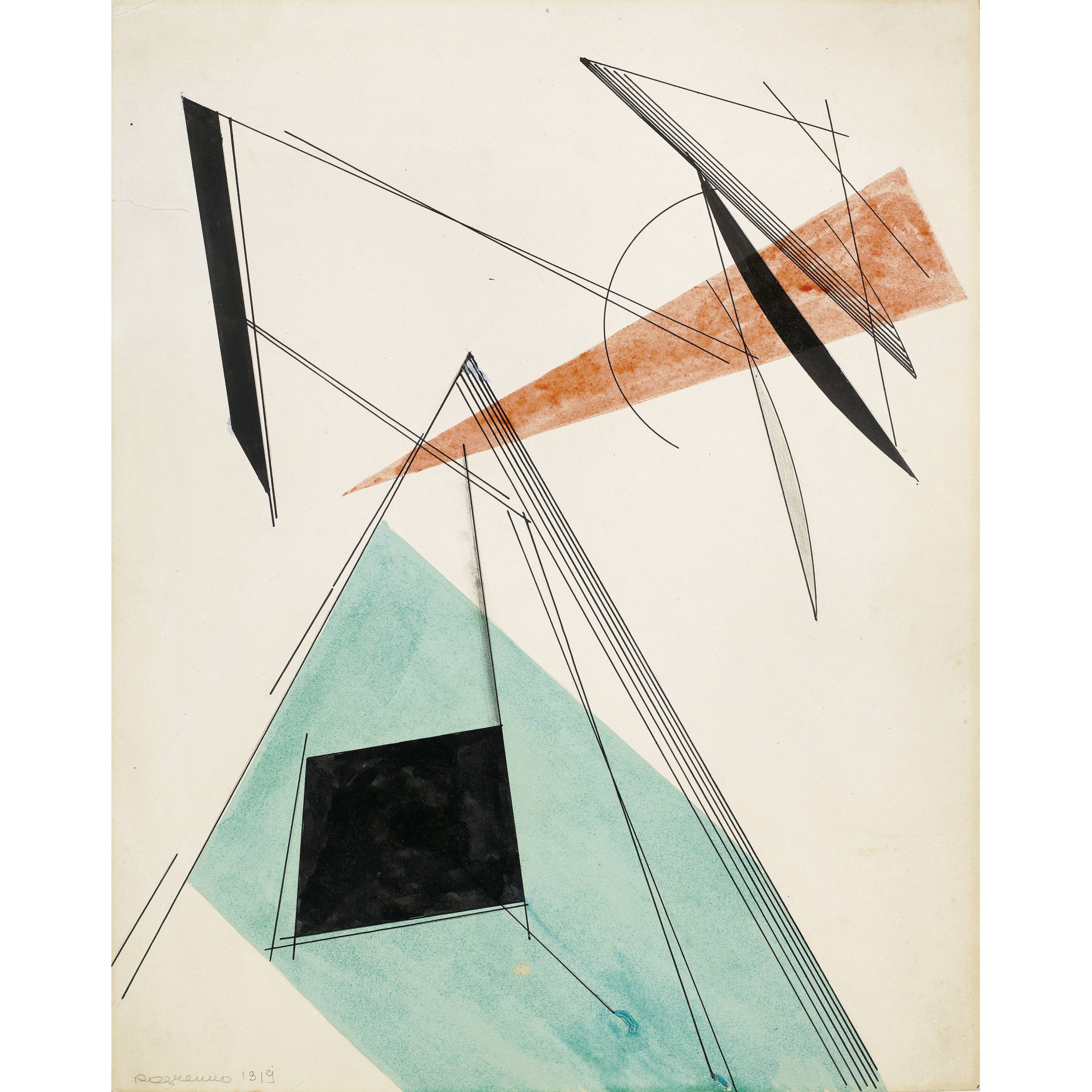- FR
S’inscrire
- Acheter
- Vendre
- Plus
- Galerie
- Commerce d'art
- Maison d'Édition
- Kornfeld aujourd’hui
- L'histoire de la Maison
- Informations
Note : L'image ne peut pas être affichée pour des raisons légales. Pour plus d'informations, voir le PDF du catalogue : Lien vers le PDF
Sankt Petersburg 1891 - 1956 Moskau
1919
Watercolour and ink
37,2x29,3 cm
At the bottom left of the artist in pencil in Cyrillic signed and dated "Rodchenko 1919". On the reverse in pencil inscribed "Rodchenko / Property of the Museum" and the inventory number of the museum "30.36"
Gift of the artist to the Museum of Modern Art, New York (1936), on the reverse with several labels of the museum and the inventory number "30.36"
Annely Juda Fine Art, London
Saidenberg Gallery, New York; from there
Private collection USA
London 1983, Annely Juda Fine Art, The First Russian Show - A Commemoration, Kat. Nr. 64, reprod. pag. 131
London 1984, Annely Juda Fine Art, Dada - Constructivism, Kat. Nr. 127
On firm, cream-coloured wove paper. Light tan on the outermost edges. On the left side with old backed tear. Single creases. At the top in the middle a small tear nail hole. With studio traces on the back
Rodchenko led the circle of younger artists that gathered around the Suprematist Kasimir Malevich. From 1914 onwards he created abstract compositions with a compass and a ruler which are classified as "non-objectivist". Compared to other Suprematists, his works are less radical in their use of colors and forms, always exuding a strong dynamic. From 1920 onwards he turned away from the Suprematist doctrine and only created "constructivist" works; later he even declared art "dead" and ended up working exclusively in commercial graphics, photography and design. Alfred H. Barr, Jr., the founding director of the Museum of Modern Art in New York, was one of the first American art historians to visit the Soviet Union in 1927. There, in Moscow he also met Rodchenko. In 1936 he exhibited him in the legendary and pioneering exhibition "Cubism and abstract art". On the occasion of the exhibition in New York, the artist gave several works to the museum. Some works were later sold by the museum, including the "Composition" offered here. Works by the artist that are so well documented and are also in fresh condition rarely come to market
1919
Aquarell und Tusche
37,2x29,3 cm
Unten links vom Künstler in Bleistift in kyrillisch signiert und datiert "Rodchenko 1919". Rückseitig mit Vermerk in Bleistift "Rodchenko / Property of the Museum" und der Inventarnummer des Museums "30.36"
Geschenk des Künstlers an das Museum of Modern Art, New York (1936), rückseitig mit mehreren Etiketten des Museums und der Inventarnummer "30.36"
Annely Juda Fine Art, London
Saidenberg Gallery, New York; von dort an
Privatsammlung USA
London 1983, Annely Juda Fine Art, The First Russian Show - A Commemoration,
London 1984, Annely Juda Fine Art, Dada - Constructivism,
Auf festem, cremefarbenem Velin. Leichte Bräunung an den äussersten Rändern. Links mit alt hinterlegtem Einriss. Einzelne Knitterfalten. Oben in der Mitte ein Reissnagellöchlein. Rückseitig mit Atelierspuren
Rodchenko führte den Kreis jüngerer Kunstschaffender im Umfeld des Suprematisten Kasimir Malevich an. Ab 1914 schuf er mit einem Kompass und dem Lineal abstrakte Kompositionen, die man dem "Nicht-Objektivismus" zuordnet. Seine Werke sind gegenüber anderen Suprematisten weniger radikal in der Verwendung der Farben und Formen und strahlen stets eine starke Dynamik aus. Ab 1920 wandte er sich von der suprematistischen Lehre ab und schuf nur noch "konstruktivistische" Arbeiten; später erklärte er gar die Kunst für "tot" und arbeitete ausschliesslich an Gebrauchsgraphik, Fotografie und Design. Alfred H. Barr, Jr., der Gründungsdirektor des Museum of Modern Art in New York, besuchte 1927 als einer der ersten amerikanischen Kunsthistoriker die Sowjetunion. Dort traf er sich in Moskau auch mit Rodchenko. Er stellte diesen in der legendären und bahnbrechenden Ausstellung "Cubism and Abstract Art" von 1936 aus. Anlässlich dieser Ausstellung in New York schenkte der Künstler dem Museum mehrere Arbeiten. Einige Arbeiten wurden später vom Museum verkauft, so auch die hier angebotene "Composition". So gut dokumentierte und in der Erhaltung frische Arbeiten des Künstlers kommen selten auf den Markt
Note : L'image ne peut pas être affichée pour des raisons légales. Pour plus d'informations, voir le PDF du catalogue : Lien vers le PDF

